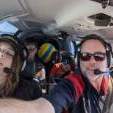Currently the FAA only allows certified NAV systems to use GPS, however, GALILEO is nearly in the regulations, so expect that to become available in the next few years. (part of why I'm holding off on avionics upgrades...it's a HW change).
Consumer devices and handhelds can use a multitude of GNSS signals. GPS, GALILEEO, GLONASS, BEIDOU. There are also regional signals like QZSS. Newer phones also use L1 and L5 frequencies from GPS and GAL, some also have BEIDOU.
Most of the constellations have multiple frequency bands to help with interference/jamming, atmospheric delays, and mulitpath. https://www.tallysman.com/gnss-constellations-radio-frequencies-and-signals/ When one tests jamming it could be multiple types of tests as people mentioned. It could be broad spectrum, specific bands, or constellations. It depends on what offense/defensive solution is being tested. One can also be testing directional antenna solutions like CRPA to null out a jammer or spoofer.
Having a tablet with GNSS, not just GPS, and VOR capability in the panel is a great backup.
Jamming and spoofing are not the only challenge for GPS/GNSS. The signals can be blocked by buildings and terrain. That's not an issue for Mooney pilots, but is an issue for drones, air-taxis, cars, and anything on the ground. There is now technology that can predict GNSS conditions to route around denied areas, or improve performance by enabling the GNSS receiver to prioritize the best signals. https://www.spirent.com/products/gnss-foresight-forecasting





